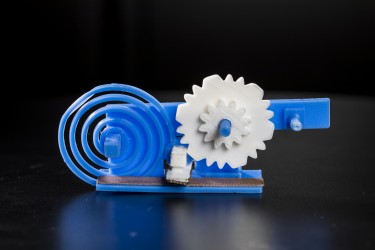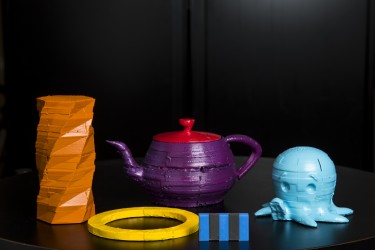By Jean-Jacques DeLisle, contributing writer
Researchers at the University of Washington (UoW) have made an interesting advancement with 3D-printed technology. At the Association for Computing Machinery’s SIGGRAPH Conference and Exhibition on Computer Graphics and Interactive Techniques in Asia this past November, developers announced that they have designed instruments that can be printed with sensors capable of communicating wirelessly with other devices without internal electronics. These new gadgets rely on simple mechanics, such as wheels, gears, and buttons, instead of advanced electronics to accomplish this interaction with other devices. This method they have dreamed up is nothing short of genius, and what this may lead to in the future of wireless tech is exciting.

One of the many mechanical instruments that can communicate wirelessly with other devices. The 3D-printed gears (in white) and spring (blue spiral) toggle a switch (white box with gray surface) made of conductive plastic. Image source: UoW.
These wireless and completely unpowered constructs function not by sending a Wi-Fi signal or radio wave but by reflecting the signal of a Wi-Fi router back to it to create a disturbance in “the force” of ambient Wi-Fi waves that the receiver in a device can then intercept. By modulating the amount of Wi-Fi signal, which is reflected by an internal antenna made of a conductive filament that mixes copper and plastic, the devices produce a signal that other devices can then detect and translate.
This innovative form of manipulating technology is now referred to as the Backscatter System.
According to the university, the signal created by these purely mechanical instruments is produced by a particular filament button pressing against the antenna pad, also made of conductive materials. To make the messages sent by these devices more informative to the electronic devices that they are communicating with, a series of gears and springs have been installed. The shape and size of the gears and springs control the rate at which the filaments button can strike. Every time the sensor button hits, the receiver picks up the move and creatively interprets that information into binary code. The resulting binary code can now be turned into natural functions produced by the electronic device; such as changing the channel on a TV or ordering an item off of Amazon. The only negative side of these creations would be the room for error in the signals and the wear-and-tear on the gears and springs, but the practical benefits surely outweigh these small cons.

Invisibly encode static data in the objects above, which could be useful for inventory tracking or to help robots interact with them. Image source: UoW.
The University of Washington has managed to create a working switch, knob, and slider with this technology that can interface with a computer or other devices, changing their volume settings and powering them on and off. The future implications of this go far beyond a sensor capable of detecting when you run low on laundry detergent, however, which is one of the instruments that the UoW has created and already released CAD models of. Try to imagine printing out custom switches and potentiometers on the International Space Station that do not need a power source. Or researchers in Antarctica 3D-printing out meteorological sensors on the fly during the harsh, cold months when bringing in equipment is costly or even impossible. Endless possibilities exist for future applications with these wireless printables.
Advertisement
Learn more about Electronic Products Magazine





